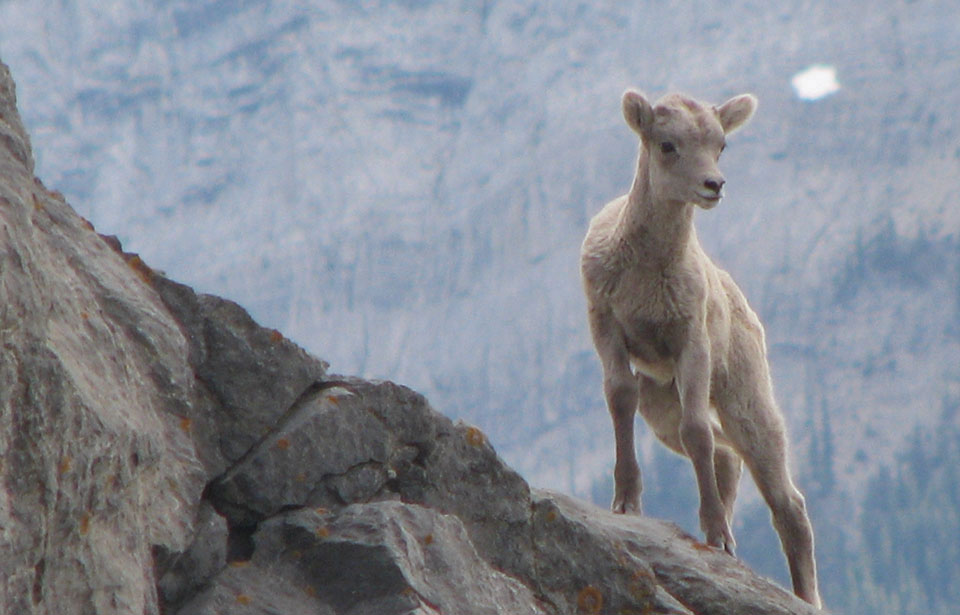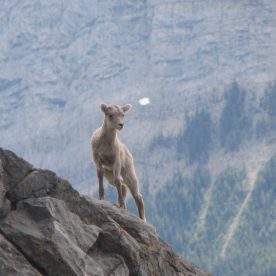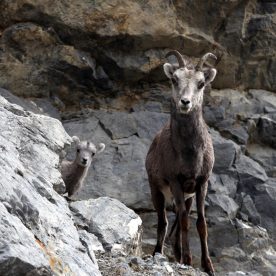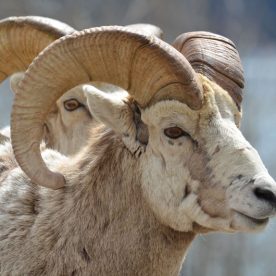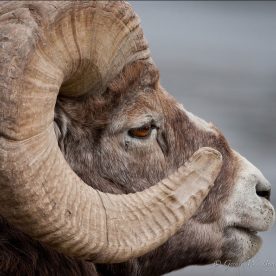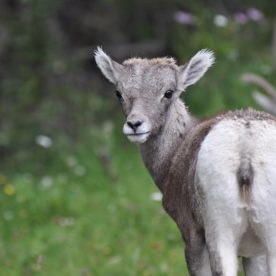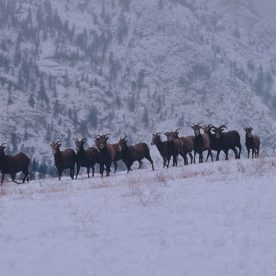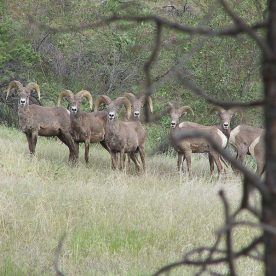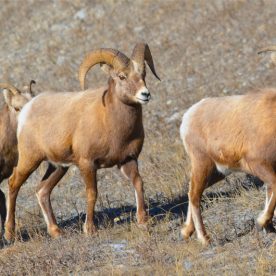Description
The wild, or mountain, sheep is a stocky, hoofed mammal, about one and a half times as large as a domestic sheep. North American wild sheep are related both to domestic sheep Ovis aries, which were imported from Europe by early settlers, and to the native sheep of Asia.
It is thought that about half a million years ago a primitive sheep similar to the present-day Marco Polo sheep of central Asia migrated into North America via the Bering land bridge, which formerly connected the regions now known as Russia and Alaska. When the great glaciers of the ice age inched south from polar centres, those animals became isolated in two ice-free areas, or refugia, one in central Alaska and the other south of the Columbia and Snake rivers, in the United States. Sheep in the Alaska refugium evolved into the slender-horned Dall sheep Ovis dalli, those farther south into the heavy-horned Rocky Mountain and desert bighorns Ovis canadensis.
As the ice sheet retreated 10 000 or 20 000 years ago, the northern sheep expanded their range east to the Mackenzie Mountains and south to the Peace River of northern British Columbia. Gradually, two subspecies, or races, of Dall sheep—one white, the other almost black—evolved. The black Dall sheep is also called the Stone sheep. In the Pelly Mountain area of the Yukon, black and white Dall sheep merge gradually with each other. The curious result, known as the Fannin, or saddle-backed, sheep has a white head, neck, and rump, but a grey body.
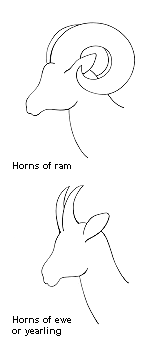 The southern sheep evolved into seven races, two of which returned to Canada after the retreat of the glaciers. Rocky Mountain and California bighorns are similar in appearance to Dall sheep, except that their coat is usually brown or grey in tone. They both have a white rump patch.
The southern sheep evolved into seven races, two of which returned to Canada after the retreat of the glaciers. Rocky Mountain and California bighorns are similar in appearance to Dall sheep, except that their coat is usually brown or grey in tone. They both have a white rump patch.
The most distinctive characteristic of male mountain sheep is their massive horns, which spiral back, out, and then forward, in an arc. Adult females have slightly curved horns about 30 cm long.
Horns of a Rocky Mountain bighorn sheep measure up to 125 cm in length and 460 mm in circumference at the base. They normally form a tight curl close to the face and are often blunt at the tips. The horns of Dall and Stone sheep are about the same length but are more slender and widely flaring, and usually pointed at the tips. The maximum circumference at the base of the Dall horn is 400 mm. The two horns of a male, with their cones, may weigh over 13 kg.
These horns grow from the skin over a conical bony core and are never shed. They grow throughout life, producing a prominent check line, or annulus, each winter when growth slows. This gives biologists a convenient means of telling age.
Fully adult Rocky Mountain bighorn rams, or males, stand about a metre at the shoulder and weigh up to 136 kg, or slightly more in the autumn when they are in prime physical condition. Average spring weight of adult rams is about 100 kg, of adult ewes, or females, about 63 kg. Dall and Stone sheep are somewhat smaller, adult males averaging less than 90 kg and adult ewes about 50 kg.
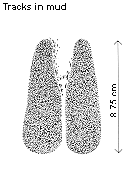
The front hoofs of mountain sheep are slightly larger than the hind, but both leave a print that is almost rectangular. A hard rim around the outer edge of each hoof surrounds a softer, concave, or curving in, area in the middle, giving excellent traction on rocky terrain.
Mountain sheep have eight sharp teeth at the front of the mouth. These are called incisors and are used to cut off plants. Their remaining teeth—molars and premolars—are deep-rooted, and adapted for chewing. All the teeth are gradually worn down during mastication and this process is accelerated if the diet includes much grit or woody material.
The pelage, or coat, of wild sheep is short and coarse, never fine and woolly, as in domestic sheep. In late summer and fall, bighorn sheep, particularly the rams, are beautifully clothed in a rich brown coat with white muzzle, white rump patch, and white trim outlining the back of all four legs. By spring, the brown coat has faded, owing to breakage of the brittle hair tips, to a drab grey-brown. Once a year, usually about June or July in southern Canada, sheep shed their hair, and until the new coat grows in, they have a scruffy, bedraggled appearance, with patches of matted old hair hanging loosely about them.
Signs and sounds
The voice of the ewe is a guttural baa, most often heard when the lambs are young; it is believed to serve as a warning of danger. Lambs make a bleating sound similar to the young of domestic sheep. The only common sound of rams is a nasal snort, usually made as a warning and when rams prepare to fight.
Habitat and Habits
Few animals are so well adapted to extremes of elevation and temperature as the magnificent wild sheep of western North America’s mountain rangelands. The females, accompanied by lambs and immature rams, and males spend the summer separately in meadows on alpine ranges.
In November and December, increasing snow forces the sheep to descend from their summer range. When mating activity lessens, in late December and January, the rams again form bachelor groups. The winter is spent on relatively small ranges of south-facing, exposed grassland.
Unique characteristics
The wild sheep was mentioned as early as 1540 by the Spanish explorer Coronado, who saw them in the vicinity of California. He described them as “Sheep as big as a Horse, with very large horns and little tails. I have seen some of their horns, the size of which was something to marvel at.”
It was the intrepid geographer David Thompson and his companion, Duncan McGillivray, who collected and preserved the first specimen of our native bighorn in 1800, near the remote upper reaches of the Bow River, just east of what is now Banff National Park.
In the years that followed, the North American wild sheep became known the world round as one of the finest and most coveted of big game trophies. Their inaccessible habitat and their alertness and speed gave any hunter who bagged one a genuine feeling of achievement.
Mountain sheep are very agile, being second only to mountain goats in their ability to climb steep terrain. However, the goat is more of a climber or “walker,” whereas the sheep, which bounds like a mule deer, can move much faster.
Mountain sheep rely on extremely acute eyesight and can detect slight movements and small objects over a kilometre away. Because an enemy cannot easily approach them unseen on the open mountain expanses, they have little need for highly developed senses of hearing or smell.
Range
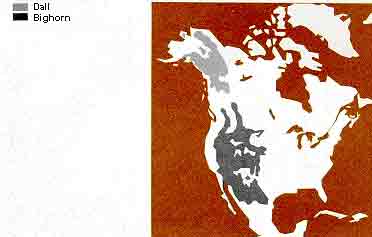 The range of the mountain sheep today extends from the snowfields of the Canadian Rockies to below sea level, on the desert floor of Death Valley, California, and from Alaska all the way to northern Mexico.
The range of the mountain sheep today extends from the snowfields of the Canadian Rockies to below sea level, on the desert floor of Death Valley, California, and from Alaska all the way to northern Mexico.
As the ice sheet retreated 10 or 20 thousand years ago, the northern sheep expanded their range east to the Mackenzie Mountains and south to the Peace River of northern British Columbia. Gradually two subspecies, or races, evolved. The white Dall sheep ranges across Alaska into the Yukon Territory and the western edge of Mackenzie District. Its almost black cousin, the Stone, or black Dall sheep, makes its home in northern British Columbia and southern Yukon. In the Pelly Mountain area of Yukon, black and white Dall sheep merge gradually with each other as the Fannin, or saddle-backed, sheep.
The southern sheep evolved into seven races, two of which returned to Canada after the retreat of the glaciers. Rocky Mountain bighorns moved north into the Rocky Mountains of British Columbia and Alberta until just south of the Peace River. California bighorns expanded into southwestern British Columbia, colonizing the arid mountains and river valleys of the Okanagan and Chilcotin areas.
Feeding
Grasses and similar low-growing plants are the staple food of wild sheep. They seldom eat the twigs of trees and shrubs that are so important to deer and moose. Wheatgrass, fescues, bluegrasses, and sedges are important foods. Clover, peavine, lupines, pasture sage, dwarf willow, and cinquefoil are eaten where available. Wild sheep eagerly seek mineral licks containing salts, mainly in spring and summer. During the winter they paw through shallow snow to find food on relatively small ranges of south-facing, exposed grassland.
Breeding
In Canada, lambs are born between early May and mid-June. Usually one lamb is born per ewe, although twins occur occasionally. The ewe retires from her flock to a secluded gully or canyon to have her lamb, which can readily follow its mother after two or three days, although somewhat unsteadily. Sheep are sociable, and the ewe quickly rejoins her flock of 10 or more ewes, lambs, yearlings, and immature rams.
Lambs suckle the ewes’ rich milk frequently at first, but begin nibbling tender plants at about two weeks of age. They are weaned, or have ceased to nurse, at about five or six months. They grow rapidly from 4.5 kg when born to about 29 kg by the end of their first summer.
Lambs are very playful, seeming to enjoy games such as “follow the leader” and “king of the castle.” Sometimes nursery groups are formed in which one ewe watches over a group of frolicking lambs while other ewes feed.
When the lambs are a few weeks old, the flocks migrate to higher, alpine summer ranges. There, the ewes and their followers fatten in lush green pastures amid alpine flowers, cascading waterfalls, and patches of perpetual snow. The adult rams, usually in groups of five to 15, spend the summer on other alpine ranges.
During the summer, rams establish an order of dominance in which rank depends on horn size. It is usually settled without serious fighting. In cases of similar horn size, however, as when separate bands meet, dominance must be settled by a fight. The victor wins the right to breed with the ewes.
A battle between two powerful, well-matched rams is an unforgettable sight. After backing off 10 or 12 m they rush together and collide headlong. The echoing crash can often be heard over a kilometre away. Luckily, a double layer of bone on the skull roof protects the antagonists from brain damage. Usually little harm results other than some splintering of the horn tips. After several bouts the rams casually separate, and it is not always apparent to the human observer which ram is victorious.
Most breeding activity, including fighting, takes place in November and December, after increasing snow has forced the sheep to descend from their summer range. As mating activity lessens, in late December and January, the rams drift away from their ewes and form bachelor groups. The winter is spent on relatively small ranges of south-facing, exposed grassland, where the sheep paw through shallow snow to find food.
Conservation
Wild sheep harbour a wide variety of parasites, but few cause any mortality. If food on winter ranges is insufficient, or winter weather is severe, the sheep may be weakened so that parasites such as lungworms, in association with pneumonia-causing bacteria, can cause epidemic die-offs, virtually wiping out entire herds. Scabies and other diseases introduced by domestic sheep can cause similar losses.
Accidental deaths from fighting, falls, avalanches, and highway traffic occur occasionally. Predators—in particular the wolf in the north and cougar in the south—consistently take old or sick sheep, but are not a threat to population survival. By escaping on cliffs too steep for other animals, a healthy sheep can almost always elude pursuit. On rare occasions predators such as coyotes, bears, lynx, bobcats, and eagles may take newborn or diseased sheep.
The most serious threat to wild sheep numbers is lack of good quality winter food. Although the summer pastures are almost unlimited, winter snows may force entire herds to feed on just a few hectares of range. Many of those ranges must be shared with domestic sheep, cattle, horses, or wild animals such as elk. Resulting malnutrition may kill sheep directly, but more commonly makes them vulnerable to death from disease, exposure, or predation.
There were probably over one million bighorns in North America at the start of the 19th century. The present population is about 25 000. Dall and Stone sheep numbers are not well known, but have changed little since pre-settlement times. The principal bighorn decline was from 1850 to 1900—a result of diseases introduced by domestic sheep, loss of ranges to livestock, and excessive hunting by man.
Luckily, recent conservation measures have halted the decline and some herds are now increasing. Many bighorns are safe within national parks and game reserves. Restrictive hunting laws and relocation of animals into formerly occupied ranges have increased numbers. As in the case of the buffalo, or bison, bighorn herds will never return to their original abundance because so much of their former range has been permanently settled or altered by man. However, it is hoped that further re-introductions, new parks and reserves, and improved livestock grazing practices will be rewarded by increased numbers of our unique and majestic bighorn.
Resources
Print resources
Banfield, A.W.F. 1974. The mammals of Canada. University of Toronto Press, Toronto
Buechner, H. K. 1960. The bighorn sheep in the United States, its past, present and future. Wildlife Monograph No. 4. The Wildlife Society, Washington, D.C.
Geist, V. 1971. Mountain sheep: a study in behavior and evolution. University of Chicago Press, Chicago.
National Geographic Society. 1979. Wild animals of North America. National Geographic Society, Washington, D.C.
Trefethen, J.B., editor. 1975. The wild sheep in modern North America. Workshop on the management biology of North American wild sheep, University of Montana, 1974. Boone and Crockett Club.
© Her Majesty the Queen in Right of Canada, represented by the Minister of the Environment, 1973, 1979, 1980. All rights reserved.
Catalogue number CW 694/16
ISBN 0-662-10774-8
Text: Donald Blood
Photo: Corel Photo Studio



